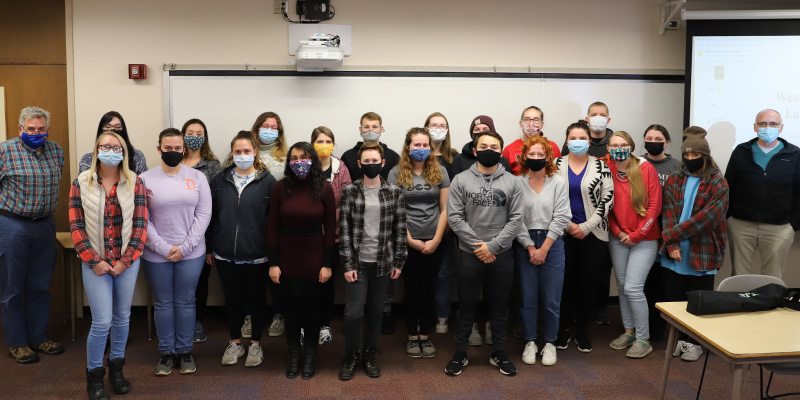Biology class playing important role in species conservation


By Val Prevish, contributor for Miami Regionals
Twenty-four students, 19 seniors and five graduate students, in Professor David Berg’s Conservation Biology class on Miami’s Hamilton campus have had the chance to impact the future of endangered wildlife through a unique opportunity to develop Species Status Assessments in collaboration with the U.S. Fish and Wildlife Service (USFWS) and the U.S. Geological Survey.
The seniors in the class were placed into five groups, each led by a graduate student. Each group developed a Species Status Assessment (SSA) for their individual target species, all of which are being considered for protection or recovery by the USFWS under the Endangered Species Act (ESA). These target species include the Black-backed Woodpecker, White Sands Pupfish, and several small plants: Western Jacob’s Ladder, Leoncita False-Floxglove, Ousterhout Milkvetch, and Penland Beardtongue.
In addition, students worked with mentors from the USFWS who met with them remotely via Zoom throughout the semester to provide guidance and feedback on their progress. The five USFWS mentors are Nathan Allan of Austin, Texas; Peter “Bjorn” Erickson of Sacramento, California; Craig Hansen of Denver, Colorado; Susan Oetker of Atlanta, Georgia; and Laura Ragan of Minneapolis, Minnesota.
The project is an opportunity for students to develop real world research that could lead to important changes for the protection of native species.
“This is one of the most original projects I’ve done as a teacher,” said Berg. University Distinguished Professor of Biology and of Biological Sciences. “It’s an extraordinary opportunity for students to work with government agencies to identify best-practice science that will make a difference in conservation. The students are doing ‘real’ work in groups. At the same time, they are providing information that will be useful to the USFWS as each species goes through the formal SSA process. So it is a win-win for the students and the agency – the former get to do work that is typically done by USFWS biologists, while the agency will get to use the SSAs developed by the students.”
In addition to working with mentors from the USFWS, the students also met virtually and in-person with biological statistician David Smith of the U.S. Geological Survey, who developed the SSA process used by the USFWS. He explained the process and provided background about the history of SSA research and its importance in conservation. During his in-person visit, Smith also gave feedback as the students presented some of their preliminary analyses.

The project has unfolded over the course of the fall term. Students used the established framework of the SSA to understand their assigned species’ current condition and future conditions. They then reviewed current literature to identify critical characteristics of the target species, analyzed threats, estimated viable population sizes, and determined gaps in current protections. They consulted peer-reviewed scientific papers, agency reports, and expert-authored white papers to collect their data.
By the end of the term, each team will have produced an SSA document for use by the USFWS biologists as they develop the agency’s recommendations. The final document will eventually be presented to USFWS decision-makers who ultimately determine whether the target species is placed on the Endangered Species List, and thus receives protection under the ESA, or, in the case of species that are already listed, how the species will be recovered. The SSA provides the scientific basis for such decisions.
The Endangered Species Act was created in 1973 to protect both animal and plant species threatened with extinction. The law also defined what it meant to be an endangered species. Since 1973, more than 1,600 species have received protection under the ESA, from the smallest plants to the nation’s national symbol, the Bald Eagle. A number of these, including the Bald Eagle, have recovered and been removed from ESA protection.
Ironically, Miami’s participation in the project came about partially due to the pandemic, said Berg. “The pandemic forced me to become comfortable with Zoom, which led me to reach out to government scientists across the country to work with the students,” he said. “It became a ‘lemonade out of lemons’ situation.”

